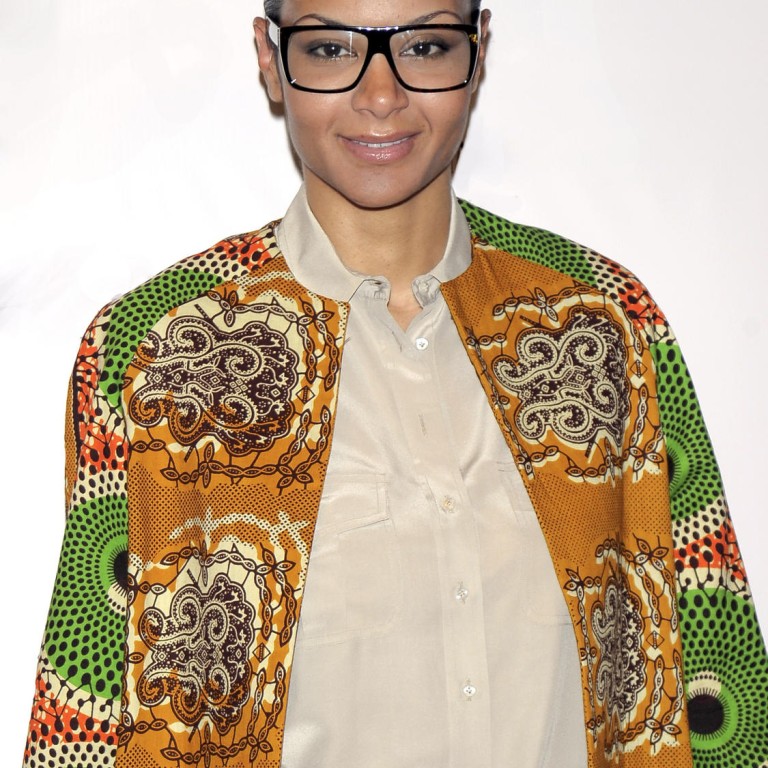
Designer Stella Jean wants to bring jobs to workers in Haiti and Mali
Italian-Haitian designer makes use of traditional skills
Among the luxe denim and 1970s boho hippie looks on the catwalks of Milan last month was the designer who has been catching everyone's eye for the past three seasons.
With a knack for vivacious prints mixed with crisp picnic-check shirts and a nostalgic 1950s-style silhouette, Stella Jean has the fashion crowd flocking to her shows, and snapping up her designs.
Jean's balloon skirts, with their idiosyncratic wax prints developed by artisans in Burkina Faso and Mali - countries barely mentioned in fashion circles - were spotted at London and Milan, worn with mannish shirts and chic heels.
The Rome-based designer, who is of Italian and Haitian heritage, is introducing freshness and excitement to the Milan catwalks.
Giorgio Armani offered her his Teatro Armani venue last year as a venue, when she won 's Who's on Next award.

"The Armani people called me twice. I thought it was a joke, because Armani is the opposite of my aesthetic," she says.
Still, Jean accepted the invitation, and she was overwhelmed by the response.
"What was important to me was that people started to ask about the collection: where it's from and how I made it," she says.
Days after the Milan show, Jean flew to New York to present part of the collection at a United Nations lunch hosted by the UN director general Ban Ki-Moon's wife, Yoo Soon-taek.
Earlier this year, she and Franca Sozzani, editor-in- chief of , were invited to speak at the UN about her work.
"My childhood dream was to become a diplomat," she remembers. "And there I was, standing on the podium in the great hall, alongside the Commissioner for Refugees talking to the delegates."
Jean explaines how she uses her collections to bring work to people in places like Burkina Faso, Mali (where she creates her prints), and Haiti. People only know about Haiti from the 2010 earthquake, she says.

"Now I have the chance to show them the real Haiti; the colour, the heart, and the joyfulness. Haitians don't need pity, they need jobs."
Jean is surrounded by her vibrant collection in her showroom in the Navigli, in Milan's artistic quarter, just after her spring-summer 2015 show.
Tall, with her hair pulled tightly back in a bun, and wearing thick-framed glasses with a crisp shirt and black pants, Jean (pronounced the French way) pulls out jewellery that was made from painted oil cans in Haiti.
She explains how a sophisticated tailored jacket with a crazy-paving pattern was created with the traditional bogolan (cotton dyed with mud) technique from Mali.
This collection opened with long pictorial skirts inspired by Haitian villages, teamed with football-strip T-shirts representing the four capitals that she is associated with: Bamako (Mali), Port au Prince (Haiti), Ouagadougou (Burkina Faso) and Rome

"The DNA is the most important part of the collection. It starts from my own roots, and each element symbolises the specific traditions or cultures that I work with," she says.
She is very committed to her work with communities in Africa and Haiti. Her bold prints are sourced in these West African countries, and are produced in cooperation with a UN agency, the International Trade Centre and the Ethical Fashion Initiative.
Fabrics are produced on handlooms, and prints are created using a wax method, similar to batik, where melted wax is applied to the fabric before dyeing.
Jean spends time in these countries with the women, drawing inspiration from their designs. She compares the craftsmanship of some of these traditional fabrics to Western laces and embroideries: "We can learn from them," she says.
She says she is not there to offer charity, and believes that work is what gives them pride and dignity.
She adds that it is not the colour or the prints that symbolise her collections, but the Italian tailoring, which pulls together the ethnic elements.
The tailoring, the mannish stripes and the checks in the current autumn-winter collection, reflect the influence of her father, an elegantly dressed jeweller from Turin, she says. But there is a continuous play of masculine and rounded feminine shapes.
The 1950s silhouettes are inspired by her mother and grandmother: "They used to put together a Givenchy and Dior style with a Haitian touch - that's why I say I didn't invent anything," Jean says.
Born in Rome, she spent a few years in Haiti. She found her calling in fashion when she started modelling. Jean knew she had a bigger story to tell.

"Modelling wasn't interesting to me," she says, laughing. "Fashion was my way of explaining my roots and about being mixed race in Italy."
She has produced six collections since 2011, three for the Milan catwalk.
Matchesfashion's Natalie Kingham discovered her just before that: "Stella Jean first came onto my radar when she sent me her look book, four seasons ago. I was attracted to the styling, which was exceptionally strong, as was her use of colour and print.
"When I looked at the collection up close in Italy, her clever mix of traditional fabrics in such modern shapes made me realise how interesting the label was. It just felt incredibly relevant and really stood out."
It is a bold and brave look, and one that customers are enthusiastically embracing.
Kingham notes that they are wearing the collection exactly as it is styled in the lookbook, which she says is rare.
It is a measure of how Jean's eye-catching prints and Italian-Caribbean mix-and-match style are catching women's imagination and, the designer hopes, their conscience, too.

